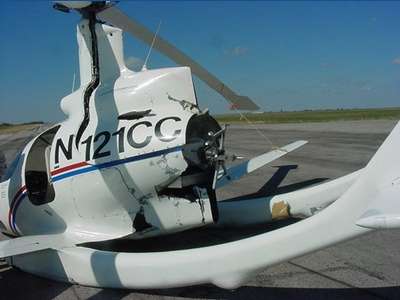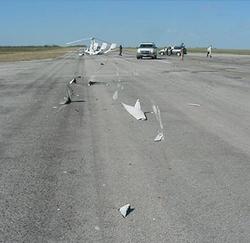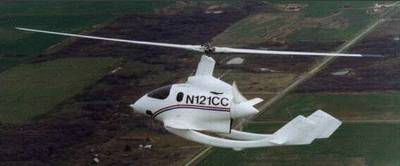OSAC to Partner with Carter to Restore the 'CCTD'
The Organization for Sport Aviation Competition (OSAC) and
2002 ANNie Award-winning Carter Aviation
Technologies have agreed to restore the prototype
CarterCopter, which after having flown successfully for more than
four years in a slow progression of testing sequences to validate
Carter's unique gyroplane technology, was badly damaged in a gear-up landing on
April 8, 2003. The accident occurred at a critical phase in
Carter's development plan and the CCTD was scheduled to be
abandoned.

Anita Infante, President of OSAC, became aware of the
discussions to scrap the CCTD and suggested an alternative. OSAC is
a public charity whose primary purpose is to support and provide
educational programs to the general public. In addition, its focus
is to build a greater understanding of the history and impact that
experimental aviation has had on society and to support the field
of sport/experimental aviation through competitive events.
According to Ms. Infante, "My board of directors and I believe that
the CCTD has tremendous importance as a revolutionary and historic
aircraft and that it should be restored for educational purposes
for future generations. We also feel strongly that the CCTD, as a
development of experimental aviation, should be the aircraft to
break the Mu-1 Barrier."
 Infante pointed out that
the two most important aviation prototypes that constitute the
heritage of the CCTD -- the 1903 Wright Flyer and the Cierva C.4
Autogyro -- are no longer in existence [the 1903 Wright machine in
the NASM is largely the result of a reconstruction --ed]. She
continued, "I assume that, like the CCTD, these prototypes had
served their purpose and it wasn't considered good business sense
to repair or maintain them. Sadly, these icons in aviation history
have now been lost to the generations whose lives they so
dramatically changed." OSAC has agreed to help save the CCTD
through a grass-roots fundraising initiative so that it will be
available to future generations for centuries to come as an example
of the personal achievement that is possible when we dare to dream
beyond the known.
Infante pointed out that
the two most important aviation prototypes that constitute the
heritage of the CCTD -- the 1903 Wright Flyer and the Cierva C.4
Autogyro -- are no longer in existence [the 1903 Wright machine in
the NASM is largely the result of a reconstruction --ed]. She
continued, "I assume that, like the CCTD, these prototypes had
served their purpose and it wasn't considered good business sense
to repair or maintain them. Sadly, these icons in aviation history
have now been lost to the generations whose lives they so
dramatically changed." OSAC has agreed to help save the CCTD
through a grass-roots fundraising initiative so that it will be
available to future generations for centuries to come as an example
of the personal achievement that is possible when we dare to dream
beyond the known.
When ANN talked with Ms Infante, we asked if
concentrating efforts on bringing the CCTD back to airworthy status
might slow the development of the NxCC (next generation
CarterCopter). She told us that it will, to one extent; but that
the benefit of Carter's having a machine to demonstrate, long
before the NxCC would be ready, would offset the delay to a large
extent. With the rebuilding now underway, there is a good chance
that the CCTD will be flying at Oshkosh, she told us.

In consideration for OSAC's partnership, Carter has agreed to
restore the CCTD with the intent to use it to break the Mu-1
Barrier. In addition, Carter has agreed that once restored the CCTD
cannot be sold, but must be donated to a public museum or
other public education program. In order to maintain the original
schedule for breaking the Mu-1 Barrier in November of this year,
Carter has temporarily canceled production work on their next
generation CarterCopter and is using that funding to begin repairs
to the CCTD. As financial support becomes available through OSAC's
funding campaign the donations will be credited toward the
restoration.
Contributions to OSAC for the Mu-1 Member's Club are tax
deductible for federal income tax purposes. contributors
receive neat premiums and privileges, which are outlined on the
sebsite, where the Mu-1 Member's Club is explained in detail. (Note
that Carter Copters has a new URL.)
 ANN's Daily Aero-Term (12.19.25): Ultrahigh Frequency (UHF)
ANN's Daily Aero-Term (12.19.25): Ultrahigh Frequency (UHF) NTSB Prelim: Cirrus Design Corp SR22T
NTSB Prelim: Cirrus Design Corp SR22T Classic Aero-TV: The Red Tail Project--Carrying the Torch of the Tuskegee Airmen
Classic Aero-TV: The Red Tail Project--Carrying the Torch of the Tuskegee Airmen Aero-News: Quote of the Day (12.19.25)
Aero-News: Quote of the Day (12.19.25) Airborne 12.17.25: Skydiver Hooks Tail, Cooper Rotax Mount, NTSB v NDAA
Airborne 12.17.25: Skydiver Hooks Tail, Cooper Rotax Mount, NTSB v NDAA





